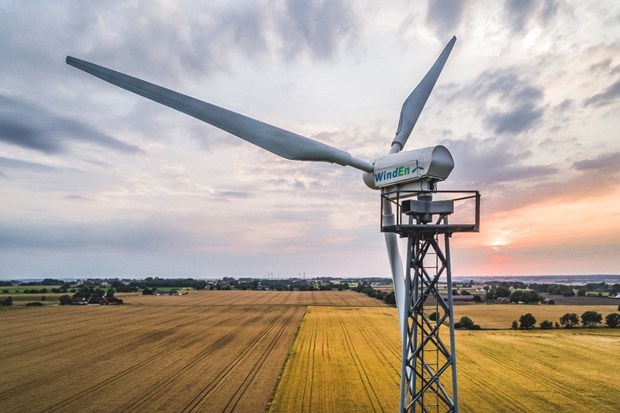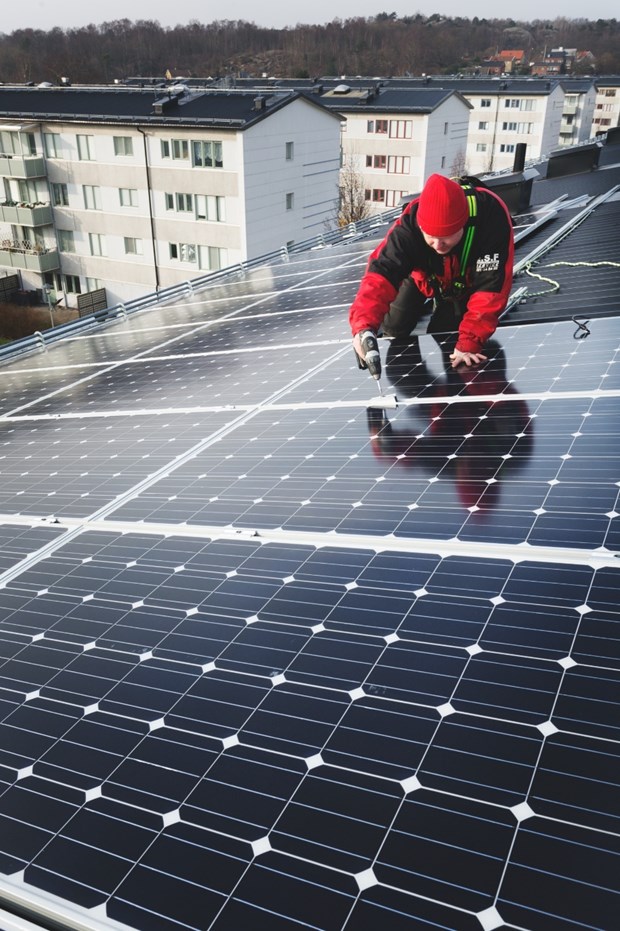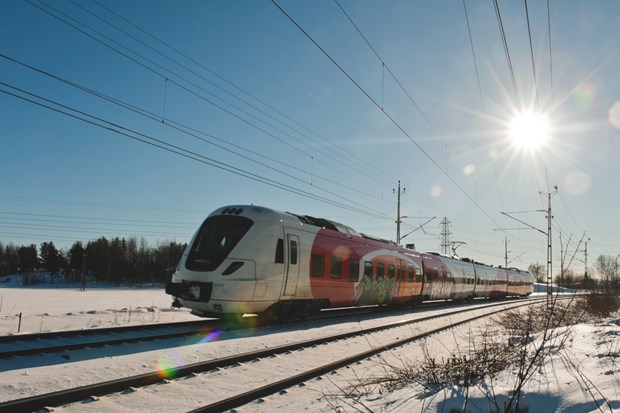Generating power for green recovery and sustainable future
 With over 50 percent of energy from renewable sources, Sweden has the highest share of renewable energy among EU Member States. Sweden aims to have all its electricity generation consist entirely of renewable energy by 2040. There are about 3,600 wind turbines in Sweden, producing 17,5 TWh of electricity per year.
With over 50 percent of energy from renewable sources, Sweden has the highest share of renewable energy among EU Member States. Sweden aims to have all its electricity generation consist entirely of renewable energy by 2040. There are about 3,600 wind turbines in Sweden, producing 17,5 TWh of electricity per year.Hanoi, (VNA) - In the wake of Vietnam’s first ever National Energy Summit in July 2020, Swedish ambassador Ann Måwe reflects over Sweden’s journey, and areas where the two countries can cooperate in the development of renewable energy.
"More than half of the energy used in Sweden comes from renewable energy sources. The country is on track to run entirely on renewable energy by 2040. Lowering carbon emission is key in Swedish policy making, resulting in both emission reduction and economic growth. Also in Vietnam the development of renewable energy takes big steps forward. But while renewable energy is rapidly becoming the most cost-effective alternative, development of a smart and energy saving grid and power storage systems becomes crucial. This is a challenge both in Vietnam and Sweden.
I was born in the Northern part of Sweden and grew up in a coastal city called Luleå, 192 km from the Arctic Circle. The city has around 77,000 inhabitants today. At the beginning of the industrialisation, there were steel, iron ore, pulp and paper factories built around the area. These have declined to some extent – though Luleå’s waterfront steel mill is still in business.
This steel mill is now planning to be the first one in the world to use hydrogen made of renewable electricity, instead of dependence on carbon. If it works out it will be revolutionary since the steel industry is the worst carbon emitters of all industry types.
Another example of what is happening in Luleå is the arrival of the Facebook servers. When the company needed to locate its European servers, Luleå turned out to be the perfect place. The facility of 27,000 square meter opened in 2013 and was Facebook's first data center outside the U.S. The Luleå warehouse is massive, 300 metres wide by 100 metres long, and the size of four football fields. Some of the main points of attraction include the naturally cold environment, a local tech university which helps supply skilled labor to the tech companies and most importantly, the access to renewable energy at relatively low costs. According to Facebook, its Luleå warehouse is the most energy efficient and sustainable computing facility ever built. The establishment of Facebook green data centre has contributed to creating new jobs, attract more foreign investors and increase the overall visibility of Luleå as a green city for business.
High energy consumption doesn’t have to mean high carbon emissions
The story of Luleå is just an example of what has been going on in Sweden for years. The country has taken a path to become one of the world's first fossil-free welfare nations. Cutting-edge technology, a wealth of natural assets and a high proportion of renewable energy, Sweden has decided to lead by example as it shifts to more sustainable energy systems.
Right up until the early 1970s, Sweden depended heavily on oil for energy supply. 75 percent of energy generated came from oil. After the 1973 oil crisis, Sweden has invested extensively in the search for alternative energy sources. Fast forward to 2020, Sweden’s rate of waste-recycling is up to 99 percent and per-capita carbon emission is lowest among developed countries. Sweden has ranked #1 in terms of energy transformation for three consecutive years (2018-2020) by the World Economic Forum (WEF). This means we are a forerunner for transition to a secure, sustainable, affordable, and inclusive future energy system.
Large share of renewable energy
According to the International Energy Agency (IEA), the average Swede releases 4.25 tonnes of carbon dioxide (CO2) per year into the atmosphere, compared with the EU average of 6.91 tonnes and the US average of 16.15 tonnes. The reason lies in the fact that the vast majority of electricity supply comes from hydroelectric, nuclear and wind power production, with wind power being the fastest growing source.
 Though it still represents a marginal portion of total energy output, solar energy contributes to Sweden’s ambition to have zero net greenhouse gas emissions by 2050.
Though it still represents a marginal portion of total energy output, solar energy contributes to Sweden’s ambition to have zero net greenhouse gas emissions by 2050. To be fair Sweden’s emissions from imported products are increasing at the same time, with many Swedish companies producing there goods abroad, which are later being consumed in Sweden. This is why the issue of cutting carbon emissions and investing in renewable energy truly is an international one. The challenge is also connected to patterns of consumption in industrialized countries, which must change.
Sweden introduced green electricity certification in 2003 to promote renewable energy. To qualify, electricity must come from wind, solar, geothermal or wave power, biofuels or smallscale hydroelectric plants. Electricity retailers are required to buy a proportion of ‘green electricity’ as part of their normal supply, while power producers receive certification for their green portfolios.
Wind power has been the fastest growing source of renewable energy around the world in recent years, and capacity is expanding in Sweden. Since 2000, Swedish production has increased from 0.5 to 17.5 TWh of electricity per year. Today, there are about 3,600 wind turbines around the country. A shift is now on-going to install larger turbins with much higher capacity.
Conserving energy in industry
In 2005, Sweden introduced a special five-year programme designed to boost energy efficiency in industry. Under this programme, the 180 or so powerintensive industries taking part were granted tax relief in exchange for drawing up energy plans and taking steps to reduce energy use. When it ended in 2009, the programme had yielded energy savings of about 1.45 TWh per year, equivalent to USD 59.4 million. It has now been reintroduced. This time, the programme will involve up to 90 industries that together account for a fifth of the country’s total electricity consumption.
Reinventing for cleaner transportation
A good public transport system is a given for any city with sustainable goals. In Sweden, making public transport the obvious and cleanest choice has been on the agenda for decades. In Gothenburg – Swedish second biggest city, a collaboration called ElectriCity is underway between industry, government and academia. Electric Volvo buses, under that collaboration, are powered entirely from wind and hydro power. They now operate one line on the streets with 80 per cent more energy efficiency than a conventional diesel powered bus. ElectriCity initiative was awarded the European Solar Prize 2015 by the European Association for Renewable Energy.
For cleaner transportation, the European Union has set a target that 10 per cent of all transport fuel should be derived from renewable sources by 2020. Sweden’s own policy goal is a totally fossilfree vehicle fleet by 2030. Progress so far made is attributed partly to increased use of ethanol and there have been several government initiatives to speed up the transition, including a law that requires larger pump stations to provide at least one alternative fuel, and tax exemptions for vehicles that emit low or no levels of CO2. The latest development is a fast shift towards cars powered by electricity. In parallel important investments are being done in the country’s railway system.
 Running on clean energy, Sweden’s domestic rail system is among the most environmentally friendly in the world.
Running on clean energy, Sweden’s domestic rail system is among the most environmentally friendly in the world.Energy-efficient households and heated buildings
Some of our houses are kept warm by the heat given off by their occupants and electrical appliances. The first passive house in Sweden was a townhouse completed in 2001. Since then, the concept has become more ambitious in scale. Not only have more buildings followed, but larger ones as well. In the southern town of Växjö, there are passive highrises, and in Stockholm, the body heat from commuters passing through the central railway station is used to heat a nearby building.
Since 1 January 2008, a new law on energy declarations has been in force in Sweden. A declaration, used in conjunction with a sale, for example, is designed to show clearly how much energy a building consumes in comparison with others. Based on an EU directive and applying to all owners of private homes, blocks of flats and other premises, the declaration scheme aims to promote more efficient energy use.
The government is also investing heavily in information and advice for households on how to save energy. Each among 290 municipalities has an energy adviser to whom people can turn for help and guidance. Advice is available on topics such as replacing windows, using low energy lights and switching to different heating systems.
Changes on the power market
Since its deregulation, the Swedish power market has made it easier for consumers to choose environmentally friendly energy. Since 1996, customers have been able to choose their power supplier, and today around 200 companies sell electricity to Swedish consumers. Much of Sweden’s electricity is produced in the north, but this region uses less than the more populous south of the country. This is one reason the country was divided into four power price areas in 2011, with the aim of offsetting the costs of energy loss incurred when electricity is transported along power lines. Another reason was to facilitate power trading between Sweden and other countries in Europe. A remaining challenge is the transmission of energy from the north to the south of Sweden. Too keep up the pace of the expansion of wind power, fast and decisive investment in the grid is needed. The technique is available and the decision makers need to take rather costly decision but with a guaranteed long-term positive effect on reliable energy supply.
Great potential for energy cooperation: Sweden-Vietnam
Sweden and Vietnam have a long history of cooperation in the energy sector. Historically the focus was on hydropower. Today it has shifted to climate smart energy solutions such as no waste transmission grids, 4G/5G implementation in the grid, waste-to-energy schemes, as well as energy storage systems in order to support Vietnam’s efforts to increase its share of renewables, in particular wind and solar, in the energy mix.
Vietnam has been successful in limiting the spread of Covid-19 in society. As such Vietnam has the potential to overcome economic consequences of COVID-19 through “building back” in a better and more sustainable way. I believe Vietnam can be a leader in the region to demonstrate clean, inclusive and resilient recovery, building on the principles of the Paris Agreement and the Sustainable Developments Goals. And not only because it benefits people and the climate, it is also good business.
Vietnam is at a crossroads. Its energy consumption is fast increasing. Critical decision needed to be made urgently on whether the development of the country still relies much on coal-fire power as now or not. Renewable energy is increasingly cost -competitive, thus, has great potential to meet the enormous demand for energy of the country.
I understand that green energy development has become a major policy orientation in Vietnam. In a short period of time, despite relatively new initiatives, Vietnam has achieved remarkable outcomes in developing clean and renewable energy. In 2019 and early 2020, it witnessed large investments in solar and wind energy with more than 4.5 Gigawatt of solar power connected to the national grid. In coming time, there will be more renewable energy projects, especially near-shore and offshore wind projects commissioned. This shift would also allow Vietnam could also set more ambitious Nationally Determined Contributions (NDC) ahead of the COP26 summit in 2021.
At the moment, there are only three waste-to-energy factories in Vietnam signing PPA (Power Purchasing Agreement) with Electricity of Vietnam (EVN), generating limited amount of energy from wastes. This contrasts massively with the potential waste-to-energy capacity in Vietnam, as the amount of potential energy in 2020 is 25 times higher than the currently installed capacity.
Sweden finds good synergy between Vietnam and Sweden in many of those areas and would like to seek further collaboration opportunities. There are many Swedish companies active in the energy sector, not only in Vietnam, but also worldwide such as ABB, Ericsson, Hexicon and Linxon. They provide technological innovations. In addition, Sweden can offer financing solutions through Swedish export credit agencies such as The Swedish Export Credit Corporation (SEK), The National Export Credits Guarantee Board (EKN) and Sweden's Development Finance Institution (Swedfund). They are already in discussion with Vietnamese counterparts regarding issues such as transmission networks upgrade, 4G/5G implementation in the grid and energy storage systems to increase renewables share in the energy mix.
Clean development is the opportunity for economic development in the world today. Our Swedish experience has shown that fossil free development pathway is both possible and better. The fact that major international business actors have now started to move their investments away from fossil energy is a clear sign that the future development is in low carbon economies.
Ensuring a green recovery post COVID-19 and fast-track a sustainable energy transition are keys to promoting Vietnam 's competitiveness and attractiveness internationally as quality investment destination at the same time as it contributing to the global fight against climate change. /.













